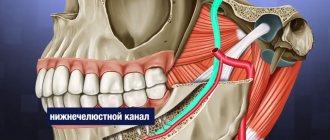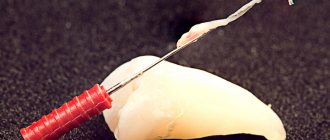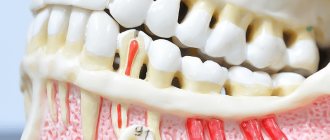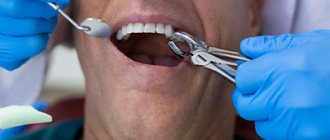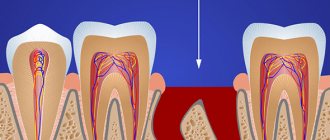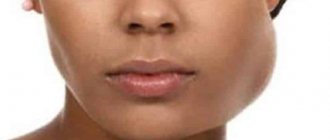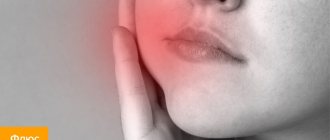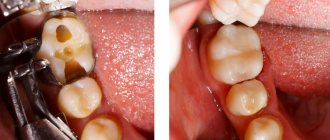Causes of inflammatory damage to the trigeminal nerve
Factors contributing to inflammation of the trigeminal nerve are:
- surgical interventions on the jaw bones;
- fractures of the base of the skull, lower and upper jaws;
- tumors;
- complex tooth extraction;
- hypothermia;
- surgery on the maxillary sinus;
- improperly administered anesthesia;
- incorrectly performed dental prosthetics;
- metabolic disorders;
- the presence of foreign bodies that irritate the nerve trunk or injure nerve endings;
- bacterial or viral infection;
- various types of intoxication of the body;
- hypovitaminosis;
- weakening of the immune system.
Local swelling
Varicose veins. Swelling (usually in the lower third of the leg, bilateral, but sometimes asymmetrical, more pronounced on the affected side) occurs in people who have suffered from varicose veins for a long time. It appears after standing for a long time and goes away in the “lying down” position with raised legs. Varicose veins are clearly visible, which helps make a diagnosis.
Deep thrombosis and saphenous vein thrombophlebitis
Swelling of the limb due to blockage of the veins by blood clots occurs after childbirth, surgery on the abdominal organs, with a tumor, leukemia and some other diseases. In acute thrombosis and thrombophlebitis, swelling is often one-sided, appears suddenly, increases and subsequently becomes permanent. Characteristic symptoms of pain are revealed. With thrombophlebitis, local compaction and hyperemia of the limb occurs along the affected vein.
Postthrombophlebitic syndrome
First appearing with venous thrombosis, edema is constantly present. It is often unilateral and can involve the lower leg and thigh. After a few years, varicose veins of the affected limb, characteristic pigmentation, compaction of subcutaneous fatty tissue and trophic skin disorders (venous dermatitis and eczema, trophic ulcers) may appear.
Lymphedema
The feet and legs swell; in the last stages of the disease, the thigh may also swell. The lesion is often unilateral. Swelling at the initial stage of the disease is temporary, then becomes permanent. In advanced cases, the swelling becomes very dense, fibrous growths appear on the skin of the feet and legs. The triggering factor may be repeated erysipelas, oncological diseases of the intestines and pelvic organs, bacterial and parasitic lesions of the lymph nodes of the groin area.
The combination of lymphedema with varicose veins is called phlebolymphedema. Swelling is often bilateral, and there may be trophic ulcers on the skin.
Joint diseases
With diseases of the joints and flat feet, the area close to the affected area swells.
Brain diseases
In case of a brain tumor, encephalitis and other diseases of the central nervous system, accompanied by paralysis of a limb, there may be swelling on the side of the paralysis due to impaired muscle contractility and paresis of peripheral vessels (persistent dilation).
Injury
When injured, small blood vessels rupture, causing a hematoma. The affected area swells. Cerebral edema is especially dangerous due to traumatic brain injury.
Idiopathic orthostatic edema
When translated into “ordinary” language, the term means that the cause of this type of edema has not been established and it appears when a person is in an upright position. Mostly young women suffer; temporary swelling occurs in the lower part of the legs.
Edema in obliterating atherosclerosis
Edema develops as a result of an increase in pain in the patient when his legs are in the “lying” position. Critical ischemia develops. The patient is forced to lower the affected limb(s) from the bed to relieve pain, since at this stage of atherosclerosis painkillers no longer help. The only way to sleep without pain is a forced position with your legs lowered from the bed. As a result, a stagnation process develops in the limb and swelling occurs.
Symptoms of trigeminal neuritis
The maxillary trigeminal nerve consists of three types of nerve fibers:
- vegetative;
- motor;
- sensitive.
The symptomatic picture of neuritis may vary depending on which fibers were affected by the inflammatory process.
Damage to sensory fibers
In particular, with inflammation of the sensory fibers, the patient may complain of a tingling sensation, numbness, and weakened sensitivity in the area innervated by the trigeminal nerve.
Damage to motor fibers
When motor fibers are damaged, there is a partial or complete decrease in strength in the innervated muscles, their atrophy and deterioration of tendon reflexes.
Damage to vegetative fibers
When the vegetative fibers are inflamed, the patient experiences cyanosis and swelling of the skin, dryness and thinning of the skin, and the potential risk of developing a trophic ulcer increases.
General swelling
Pulmonary heart failure. Under the influence of gravity, edematous fluid accumulates in the lowest part of the body. In bedridden patients, these are the areas of the sacrum and lumbar region. Associated symptoms are shortness of breath, swelling of the neck veins, congestive liver, ascites, hydrothorax and other signs of pulmonary heart failure.
Kidney diseases
With glomerulonephritis, pyelonephritis and other kidney diseases, swelling forms first on the face (on the eyelids), and then on the limbs and torso. With the development of nephrotic syndrome, edema can gradually spread to the entire body, including serous cavities (in this case they speak of edematous syndrome).
Cirrhosis of the liver
In addition to edema, there are other signs of liver cirrhosis - ascites, dilation of the esophageal veins (as determined by EGD), bleeding from the esophagus, dilation of hemorrhoidal veins, and liver failure.
Exhaustion
Edema of a similar origin occurs during fasting, alcoholism and some diseases of the gastrointestinal tract, accompanied by accelerated excretion of proteins from the body. The legs and feet swell, the face becomes puffy (protein-free edema).
Pain due to inflammation
In addition, a disease such as inflammation or neuritis of the facial trigeminal nerve makes itself felt with attacks of pain of a very diverse nature:
- cutting,
- burning,
- pricking,
- tearing
- shooting, etc.
In this case, the area of pain does not always correspond to the area of innervation and can spread to the lower jaw, cheeks and chin.
Pain may be accompanied by:
- muscle spasms (facial, chewing),
- the appearance of nasal discharge,
- development of hypersalivation,
- increased lacrimation.
Lack of sensation in the tongue, lips and chin
With inflammatory damage to the trigeminal nerve, not only the entire nerve can be damaged, but also its individual branches. This is why numbness and pain can occur in various areas of the face. For example, when the lingual branch of the nerve is inflamed, patients complain of pain and sensitivity disturbances in the anterior part of the tongue, and when the mental branch is damaged, in the area of the lips and chin.
Pain when laughing, chewing, brushing teeth and shaving
Pain due to neuritis of the maxillary trigeminal nerve can intensify with touching, chewing, laughing and with changes in temperature. That is why patients, trying to prevent the recurrence of painful attacks, avoid excessive mobility and prolonged conversations, and refuse brushing their teeth and shaving.
Prevention
In windy, cold weather it is very easy to blow through a nerve. A pulling sensation on the face and soreness are symptoms that are difficult to tolerate. They interfere with normal productive life and work. For people who often catch colds, it is important to think about preventing the disease. It is easier to prevent inflammation of the facial nerve than to treat it. Preventive measures include:
- in the cold season, do not forget about hats;
- in cold weather, cover your face with a warm cloth, it can be a scarf;
- remember that drinking only cold drinks will cause colds in your teeth and throat; Because of this, neuralgia and neuritis may develop.
- treat any viral diseases that appear on the face;
- take care of yourself, especially during colds.
Neuritis of the facial nerve can be classified as a grateful disease, because it can be treated quite well.
But the severity of the disease, as well as how quickly recovery occurs, depends on timely contact with a competent specialist. Timely preventive measures are also important.
Treatment of neuritis of the maxillary trigeminal nerve
Therapy
The treatment program for trigeminal neuritis is drawn up taking into account the causes of the disease and its clinical signs. The main goals of treatment are:
- achieving a sensitizing effect;
- fight against bacterial and viral infection;
- increasing the body's immune forces;
- elimination of swelling of the nerve trunk;
- restoration of natural adaptive and compensatory reactions;
- normalization of the patency of nerve impulses.
Healing procedures
The set of procedures aimed at blocking the inflammatory process and eliminating all manifestations of neuritis includes:
- antibacterial therapy;
- antiviral therapy;
- elimination of factors contributing to the occurrence of intoxication;
- removal of tumor-like neoplasms or dissection of adhesions compressing the nerve;
- prescribing vitamin and mineral complexes to the patient;
- stimulation of nerves and muscles;
- acupuncture;
- physiotherapy (electrophoresis, phonophoresis, UHF, ultrasound, paraffin therapy).
People suffering from trigeminal neuritis are advised to regularly visit dental clinics and have their oral cavity sanitized.
Treatment methods
Self-medication is unacceptable here. When the doctor discovers that the facial nerve is cold, treatment usually begins without delay. For greater effectiveness, it is comprehensive.
Usually the doctor prescribes medications, including:
- Pharmaceuticals.
- Decongestant medications (they relieve swelling).
- Diuretics (remove excess moisture, dilate coronary vessels).
- Drugs that increase the sensitivity of nerve tissue.
- Substances to maintain muscle tissue in tone (preventing infection).
- Vasodilators (allow you to saturate the tissues with oxygen).
- Painkillers (relieve pain).
Usually, not only drug treatment is prescribed, but also special gymnastics, as well as physiotherapy. If necessary, antibiotics may be prescribed as part of complex therapy.
Important: therapeutic exercises are performed on the side that is not affected. In this case, relaxation and tension of the facial muscles alternate. Gymnastics is aimed at simulating the expression of various emotions (anger, laughter, joy, crying).
Articulatory sounds come to help in the training process.
It should be remembered that physiotherapy may have contraindications. Therefore, they are prescribed after a special examination.
Traditional medicine can also be used in complex therapy:
- Goat milk with honey before bed (the drink should be warmed before drinking).
- Flax seeds are steamed and applied to the painful area.
- Rubbing fir oil into the affected area.
- Rose tea (a drink made from red rose petals). The drink calms the central nervous system.
Many people are interested in the question of whether it is possible to heat the skin in the area of inflammation of the facial nerve. To combat the disease, you can use not only medications and therapeutic exercises. Dry heat can also be a way to relieve pain. But this method is controversial; it is better to use such treatment with the permission of a doctor.
